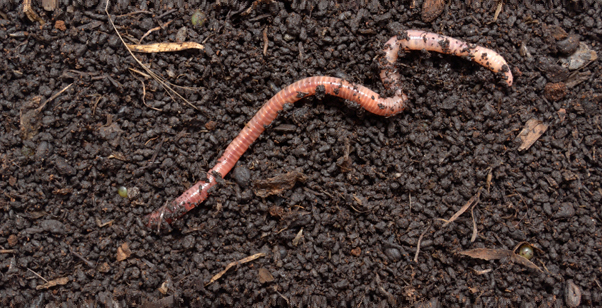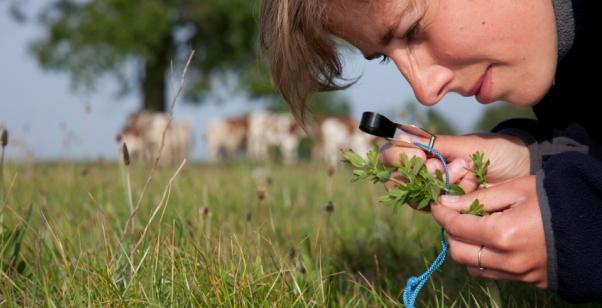Practical Biology
A collection of experiments that demonstrate biological concepts and processes.


Observing earthworm locomotion

Practical Work for Learning

Published experiments
Investigating enzymes used in laundry detergents, class practical.
Laundry detergents are a familiar application of enzyme technology in our daily lives. Detergent manufacturers have robust protocols for assessing the added cleaning value of different enzymes, with different stains, different fabrics, different temperatures.
While you cannot replicate all these tests in your classroom, groups of students could each carry out a simple investigation of one factor, while controlling other variables.
Lesson organisation
This will depend on how open-ended you allow the planning and execution of an investigation to be.
Introducing the idea that enzymes are added to laundry detergent to improve cleaning performance could be brief, or take longer if you want to introduce more ideas about enzyme action, types of fabrics, the nature of stains, and the effects of reducing laundry temperatures. If you encourage each group of students to investigate one factor and allow time for sharing reports of the practicals at the end, you could cover several aspects of the technological application of enzymes to laundry.
It might be interesting to share the reports by posting them to a website and then asking each student to review another group’s report.

Apparatus and Chemicals
For each group of students:.
Access to a range of
- staining substances
- detergents – with and without enzymes ( Note 2 )
- water (including hot water)
Stirring rods
Thermometers
For the class – set up by technician/teacher:
Non-bio detergent at a suitable dilution ( Note 1 )
Enzyme preparations to add to the detergent ( Note 2 )
Range of fabrics: cotton, linen, nylon, rayon, silk, wool ( Note 3 )
Staining substances ( Note 4 )
Health & Safety and Technical notes
Refer to safety notes provided with your supplied enzyme preparation. Handling concentrated enzyme preparations is more hazardous than handling diluted enzyme preparations. Dry enzyme powder is hazardous if inhaled, so spills should be cleared up with a damp cloth before they dry out. Technicians should wear eye protection. They should avoid raising enzyme dusts in the air when preparing solutions, and should rinse splashes off the skin quickly and thoroughly.
Students should take similar care with dilutions of enzyme in detergent solutions, but the hazard is much reduced. Wash any detergent splashes from the eyes with copious running water or an eye wash bottle.
Read our standard health & safety guidance
1 A suitable dilution of detergent is around 5%, that is 5 cm 3 of detergent per 100 cm 3 . This is calculated from the typical detergent pack suggestion of 100 cm 3 of detergent in a medium soil wash and machines using around 20 litres of water for the wash cycle.
2 Provide portions of enzymes to add to known volumes of the detergent, or make up solutions of enzymes (protease only, lipase only, amylase only) in non-bio detergent. Students mix these to make enzyme cocktails, following their investigation plans.
NCBE supplies five detergent enzymes individually or in a pack of five. They supply lipase (Lipex™) in 100 cm 3 bottles. The data sheets in the packs recommend suitable amounts of enzyme to use as a starting point for any investigation. They also provide information about the enzyme including likely optimum temperature for enzyme action. NCBE recommend testing any protocol with different concentrations of enzyme before use with students, because enzyme activity in different situations and after storage is hard to predict. Use the data sheet provided with the enzyme to guide your decisions.
3 Web research into the source and nature of the fibres in different fabrics will reveal that some are plant products (varieties of cellulose fibres), some are synthetic polymers, and others are of animal origin (protein fibres). With their knowledge of enzymes, students should be able to work out which laundry enzymes are likely to have a negative effect on silk and wool.
4 Students may devise their own stains, but could include cooking oils, fresh grass, milk, egg yolk, chocolate sauce, rich gravy, fruit juice. Encourage students to be sparing in how they stain the fabric, especially if investigating fatty stains at low temperatures.
Ethical issues
There are no ethical issues with the practical procedure. You may need to avoid handling animal products to produce stains if you have strict vegetarians or vegans in the class.
SAFETY: Rinse any splashes of enzyme solutions from the skin quickly and thoroughly. Wear eye protection when handling enzyme solutions. Clean up spills with a damp cloth before they dry. Avoid raising dust into the air with detergents and powdered enzymes. Avoid rubbing eyes after handling solutions, washed fabrics etc.
Preparation
a Make up detergent and enzyme solutions ( Notes 1 and 2 )
b Prepare fabrics to test ( Note 3 )
Investigation
c You could provide a detailed protocol for an investigation for your students, or make investigation planning part of the activity. Fabrics will need to be stained, mixed with detergent and/or enzyme solutions at a certain temperature for a certain time, agitated in some way, rinsed and left to dry before assessing the stain-removing effects of the detergent/ enzyme mixes.
Teaching notes
The use of enzymes is often preferable to traditional chemical treatment. Traditional chemical treatments are often non-specific, not always easily controlled, and may require harsh conditions. Often they produce undesirable side effects and/or waste disposal problems. Enzyme-controlled reactions often give higher product quality, lower manufacturing cost, less waste and reduced energy consumption. The technical effects of enzymes can be controlled by changing enzyme dose, temperature, and reaction time. Because enzymes are catalysts, the amount added to accomplish a reaction is relatively small. For example, an enzyme preparation in most food uses is equal to 0.1% (or less) of the product.
Enzymes used in food processing are generally destroyed during subsequent processing steps and not present in the final food product. When enzymes are used to remove stains from fabrics, clothes can be washed at lower temperatures, thus saving energy. Enzymes provide an alternative to chlorine bleach for removing some stains from cloth. Using enzymes means the level of surfactants can be reduced, and permits the cleaning of clothes in the absence of phosphates. Enzymes also contribute to safer working conditions when they allow elimination of harsh chemical treatments during production processes. (Source: Enzyme Technical Association .)
A disadvantage of using enzymes in laundry detergent is that some people experience allergic or other reactions to traces of detergent on laundered clothing. Another is that protease enzymes will damage protein fibres in fabrics such as silk and wool.
Health & Safety checked, September 2010
www.ncbe.reading.ac.uk NCBE at Reading is a source for laundry detergent enzymes, and for many tried and tested protocols using enzymes. NCBE also provide a wide range of other biotechnology practical equipment, consumables and protocols.
(Websites accessed October 2011)

IMAGES
COMMENTS
Mar 22, 2023 · Repeat the experiment with a green or eco-friendly laundry detergent with plant-based surfactants. How effective are these detergents? Whereas in this project, you simulated a wash cycle by submerging your stained cotton squares in water and shaking them, the everyday washing in many households happens in a washing machine.
School Science Projects Washing MachineWashing Machine Experiment is a easy science experiments for school students that helps us to understand about working...
A video play list of all of My Lab experiments of washing machines, dryers and in the future dish washers. lets see what happens when the abnormal happens.
soil + water and + centrifuge = ...... the pump is ....
As each dirty towel is turned in, it is placed into the only washing machine on the premises. When the washing machine has 20 towels in it, the manager flips a coin to determine which detergent will be used for that load. The cleanliness of the load of towels is rated on a scale of 1 to 10 by a person who does not know which detergent was used.
Apr 12, 2016 · He had definite ideas about what he would do differently if he were to repeat the experiment: less mustard on each square so the detergents would have a better chance of working, and he would also run the squares through the washing machine so they had a more realistic wash cycle.
Add handkerchiefs A-2, B-2, C-2 to washing machine. 33. Pour Detergent #2 into washing machine. 34. Close lid to washing machine and use “Soak” cycle. 35. After 5-minutes, wash on HEAVY DUTY cycle. 36.Transfer Handkerchiefs to dryer. 37. Dry from 30-minutes. 38. Remove handkerchiefs from dryer. 39. Gather handkerchiefs A-3, B-3, and C-3. 40 ...
Today, washing machines and modern detergents do this work for us. Our experiments provide a first insight into detergent research: What do surfactants do, and what role do temperature, water hardness and the type of fabric play?
This is calculated from the typical detergent pack suggestion of 100 cm 3 of detergent in a medium soil wash and machines using around 20 litres of water for the wash cycle. 2 Provide portions of enzymes to add to known volumes of the detergent, or make up solutions of enzymes (protease only, lipase only, amylase only) in non-bio detergent.
Washing machine; 6 cotton shirts; Pencil; Paper; Adult; Procedure: Start by washing the shirts. You may need to ask an adult to help you, but don't worry -- they won't mind if it's all for the sake of clean clothes and science. Once the shirts are washed, put four in the laundry basket. Leave the remaining two in the washing machine.